
U.S. research has shown that the susceptibility of the gut pathogen Clostridioides difficile to antibiotics is affected by other bacteria, suggesting that the entire microbiome should be considered when designing eradication treatments.
The presence of other microbes that were more susceptible to low antibiotic concentrations led to increasing numbers of C. difficile, as it was able to grow in the absence of ecological competition.
In addition, the presence of the bacterium Desulfovibrio piger made C. difficile more tolerant to the antibiotic metronidazole.
The study, in PLOS Biology, demonstrates how the ability of C. difficile to colonize, grow and function is influenced by the dense and diverse gut community in which it resides.
“These results highlight the need to consider biotic interactions in the design of future therapeutic treatments to eradicate pathogens,” the researchers suggest.
The team from the University of Wisconsin-Madison examined how interspecies interactions affected the response of C. difficile to the antibiotics vancomycin and metronidazole, which are used to treat C. difficile infections.
Vancomycin is a glycopeptide that inhibits cell wall synthesis, whose activity is specific to gram-positive bacteria.
Metronidazole is a DNA-damaging agent that is effective against both gram-positive and gram-negative anaerobic bacteria and is an inactive prodrug until its nitro group is reduced to nitroso radicals in the cytoplasm of anaerobic bacteria.
The team found that gut microbes infrequently altered C. difficile’s minimum inhibitory concentration to the antibiotics but frequently impacted its response to subinhibitory concentrations, each through distinct mechanisms.
In communities with antibiotic-sensitive species that also compete with C. difficile, the latter’s growth was enhanced in the presence of low concentrations of antibiotics due to competitive release.
The specific bacterium D. piger substantially increased C. difficile’s minimum inhibitory concentration for metronidazole. Differentially expressed genes in C. difficile in the presence of D. piger were linked with metronidazole resistance.
Further research suggested that D. piger’s impact on the environment induced a metal starvation transcriptional response in C. difficile, leading to down-regulation of enzymes required to reduce metronidazole to its active form.
Hydrogen sulfide production by D. piger promoted metal sequestration, report Susan Hromada and Ophelia Venturelli.
Supplementation of D. piger spent media with combination of metals eliminated the protective effect of C. difficile from metronidazole.
The researchers say that understanding how microbial interactions alter the antibiotic susceptibility of major human pathogens such as C. difficile could enable tailored antibiotic treatments informed by ecological context.
“This understanding could inform new microbiome interventions that selectively eradicate human pathogens while minimizing disruption of healthy gut microbiota and minimize the acquisition of antibiotic resistance.”
They added: “Our work demonstrates that pathogen growth can be altered by interspecies interactions across a wide range of antibiotic concentrations, which should be considered in the design of antibiotic treatments.”













